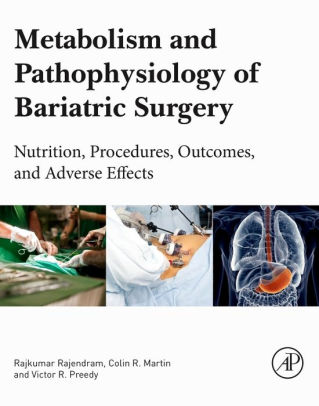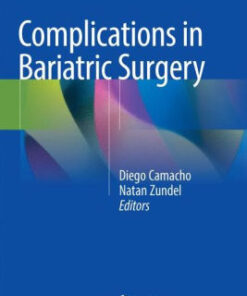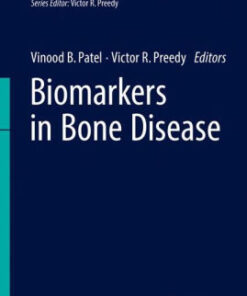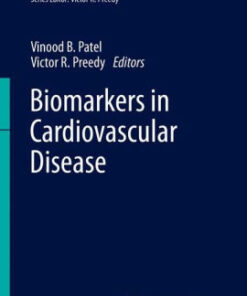(PDF) Metabolism and Pathophysiology of Bariatric Surgery by Victor R. Preedy
$18.00
Download instantly Metabolism and Pathophysiology of Bariatric Surgery – Nutrition, Procedures, Outcomes and Adverse Effects by Victor R. Preedy, Rajkumar Rajendram, Colin R. Martin. It is ebook in PDF format.
ISBN-10: 0128040114 ISBN-13: 9780128040119
Preview
This is the PDF eBook version for Metabolism and Pathophysiology of Bariatric Surgery – Nutrition, Procedures, Outcomes and Adverse Effects by Victor R. Preedy, Rajkumar Rajendram, Colin R. Martin
Table of Contents
Section I: Features of Obesity and Strategies for Weight Loss 1. Obesity and Cardiac Failure: Pathophysiology, Epidemiology, Clinical Manifestations, and Management 2. Obesity and Adipose Tissue Microvascular Dysfunction 3. Ghrelin-Producing Cells in Stomachs: Implications for Weight Reduction Surgery 4. Asthma in Obesity and Diabetes: Novel Mechanisms and Effects of Bariatric Surgery 5. Percutaneous Electrical Neurostimulation of Dermatome T6 to Reduce Appetite 6. The Management of Obesity: An Overview
Section II: Surgical and Postsurgical Procedures 7. Why Patients Select Weight Loss Bariatric Surgery 8. Best Practices for Bariatric Procedures in an Accredited Surgical Center 9. Anesthesia for Bariatric Surgery 10. Laparoscopic Roux-en-Y Gastric Bypass 11. Omega Loop Gastric Bypass 12. Laparoscopic Sleeve Gastrectomy 13. Laparoscopic Adjustable Gastric Banding 14. Biliopancreatic Diversion 15. Endoluminal Procedures for the Treatment and Management of Bariatric Patients 16. Intragastric Balloon for the Treatment of Morbid Obesity 17. Jejunoileal Bypass: Physiologic Ramifications of an Obsolete Procedure That Has Resurfaced in Oncologic Surgery 18. Pediatric Bariatric Surgery 19. Pregnancy After Bariatric Surgery 20. Mortality Rate and Long-Term Outcomes After Bariatric Surgery 21. Critical Care After Bariatric Surgery
Section III: Safety and Outcomes 22. An Overview of the Safety of Bariatric Surgery 23. Safety of Bariatric Surgery in Adolescents 24. Mortality in Bariatric Surgery: A Focus on Prediction 25. Comparing Weight Loss in Three Bariatric Procedures: Roux-en-Y Gastric Bypass, Vertical Banded Gastroplasty, and Gastric Banding 26. Metabolic Predictors of Weight Loss After Bariatric Surgery 27. Long-Term Weight Loss Results After Laparoscopic Sleeve Gastrectomy 28. Gastric Band Slippage as an Adverse Event 29. Leaks and Fistulas After Bariatric Surgery 30. Gastric Leaks and Use of Endoscopic Internal Drainage With Enteral Nutrition 31. Gastroesophageal Reflux Disease and Hiatal Hernia in Bariatric Procedures
Section IV: Metabolism, Endocrinology and Organ Systems 32. Endoscopic Treatments for Obesity-Related Metabolic Diseases 33. Sleeve Gastrectomy: Mechanisms of Weight Loss and Diabetes Improvements 34. Postprandial Hyperinsulinemic Hypoglycemia in Bariatric Surgery 35. Bariatric Surgery Improves Type 2 Diabetes Mellitus 36. Weight Loss Surgery and the Surrogate Insulin Resistance Markers HOMA, TyG, and TG/HDL-c in Relation to Metabolic Syndrome 37. Cancer and Bariatric Surgery 38. Upper Gastrointestinal Diseases Before and After Bariatric Surgery 39. Hematological Disorders Following Bariatric Surgery 40. Enteric Hyperoxaluria, Calcium Oxalate Nephrolithiasis, and Oxalate Nephropathy After Roux-en-Y Gastric Bypass 41. Thyroid Hormone Homeostasis in Weight Loss and Implications for Bariatric Surgery 42. The Ghrelin–Cannabinoid 1 Receptor Axis After Sleeve Gastrectomy 43. PNPLA3 Variant p.I148M and Bariatric Surgery
Section V: Nutritional Aspects 44. Dietary Reference Values 45. Meal Disposal After Bariatric Surgery 46. Underreporting of Energy Intake and Bariatric Surgery 47. Control Eating Following Bariatric Surgery 48. Dietary Planning in Bariatric Surgery Postoperative 49. Protein Nutrition and Status and Bariatric Surgery 50. Micronutrient Deficiencies and Sleeve Gastrectomy for Weight Reduction 51. Thiamine (Vitamin B1) After Weight Loss Bariatric Surgery 52. Vitamin A and Roux-EN-Y Gastric Bypass 53. Iron and Bariatric Surgery
Section VI: Cardiovascular, Body Composition, and Physiological Aspects 54. Long-Term Cardiovascular Risks in Bariatric Surgery 55. QT Interval After Bariatric Surgery 56. Plasma Polyunsaturated Fatty Acids After Weight Loss Surgery 57. Bariatric Procedures and Dual Energy X-Ray Absorptiometry 58. Factors Associated with Metabolic Bone Disorders and Its Complications After Bariatric Surgery 59. Gait Patterns After Bariatric Surgery
Section VII: Psychological and Behavioral Aspects 60. Preoperative Psychosocial Assessment for the Bariatric Patient 61. Neurocognitive Factors Associated With Obesity, Obesity-Related Disorders, and Bariatric Surgery 62. Temperament and Outcome of Bariatric Surgery for Severe Obesity 63. Cognitive Behavioral Therapy for Bariatric Surgery Patients 64. Does Body Dysmorphic Disorder Have Implications for Bariatric Surgery? 65. Issues Surrounding the Relationship Between Sexual Function and Bariatric Surgery 66. Depression and Intragastric Balloon Treatment
Section VIII: Resources 67. Recommended Resources on Metabolism and Physiology of Bariatric Surgery




